Reflection Of Waves
If a moving surface wave on water strikes a wall, it is found that another wave starts moving along the surface of water in the opposite direction. Again, standing at a certain distance from a large wall if a loud sound is made, a similar sound comes back to our ears after a while.
- We know that if light falls on a mirror, it changes its direction. These phenomena are examples of the reflection of waves, though the nature of the waves are different in different cases.
- We know that the direction along which the energy of a wave is transferred is called a ray. It is represented by an arrowheaded straight line. Suppose, a ray travels through a medium and is incident at a point on an interface with another medium.
- This point is called the point of incidence. The ray striking the interface is called the incident ray. The ray returning to the first medium from the point of incidence after reflection is called the reflected ray.
- PQ is the interface of two media or a reflector, O is the point of incidence, and AO and OB are incident ray and reflected ray, respectively. The perpendicular ON on the reflector drawn at the point of incidence O is called the normal.
The angle between the incident ray and the normal is called the angle of incidence. Similarly, the angle between the reflected ray and the normal is called the angle of reflection.
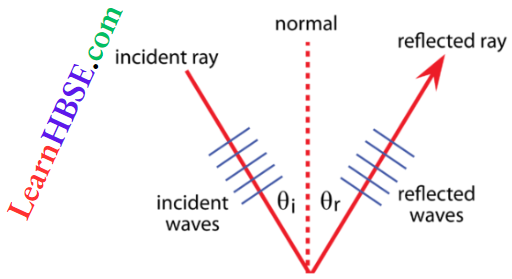
Reflection Of Waves Class 11 Important Questions
Laws of reflection of light: Reflection of waves obeys two laws. These are known as the laws of reflection.
- The incident ray, the reflected ray, and the normal to the reflector at the point of incidence lie on the same plane.
- The angle of incidence is equal to the angle of reflection, i.e., i = r.
Reflection Of Sound Definition: Sound propagates in the form of waves from one place to another. So, like other waves sound also exhibits the phenomenon of reflection.
Reflection Of Sound Experimental Demonstration:
Plane Reflector Definiton: A plane reflector R is placed vertically on a horizontal table. A tall partition P perpendicular to the reflector at O divides the table into two halves. Two tubes A and B are placed on the table in such a way that their axes are directed to O and they make equal angles with OP (i.e., ∠AOP = ∠BOP).
- Now, if a source of sound (for example, a table clock) is placed in front of tube A and a receiver (for example, an ear) is placed in front of tube B, the sound of the clock is heard distinctly.
- Due to the partition in the middle, the sound of the clock cannot reach the ear directly rather after being reflected at O of the reflector it reaches the receiver, i.e., the ear. If ∠BOP is changed a little by rotating the axis of the tube B or by raising the tube from the table slightly, sound is not heard anymore.
From this experiment, it is evident that
- Sound has been reflected from the reflector,
- The angle of incidence is equal to the angle of reflection and
- The incident ray, the reflected ray, and the normal at the point of incidence lie in the same plane (plane of the table).

Reflection Of Waves Class 11 Notes
Concave Reflector: Two concave reflectors A and B are placed in such a way that their axes lie on fee same straight line. A source of sound (for example, a table clock) is placed at the focus of A.
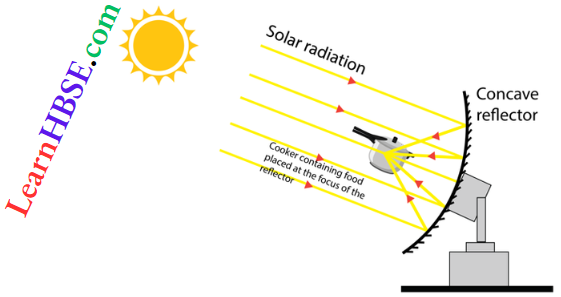
The sound waves produced by the clock get rejected from fee reflector A and propagate parallel to the axis. These parallel waves are Incident on the reflector B and again get reflected from Its surface. They meet at fee frees, of 3, If we place our ear there, a distinct sound is heard.
Size Of The Reflector: To obtain an effective reflection of a wave from a reflector, the fee size it should be much greater than a feat of the wavelength. The wavelength of audible sound in air varies from 1.5 cm to 16 m. On the other hand, the wavelength of visible light varies from 4 x 10-7 m to 8 x 10-7 m, ie., a sound wave is much longer than a light wave. So tight can be reflected from very small reflectors, but for reflection of sound the size of the fee reflector should be very large.
- Regular reflection of waves takes place from a smooth reflector. If the surface of the reflector is rough, diffused reflection takes place. Whether a surface is smooth or rough is known from fee knowledge of fee wavelength. For example, a large wall may look smooth to the naked eye, but it has many fine notches.
- However, these notches are much smaller than the wavelength of sound. So in case of reflection of sound, a large wall may be taken as a smooth reflector, and regular reflection of sound takes place from it. On the other hand, fee notches of that wall are many times larger than the wavelength of light, and hence, light suffers diffused reflection from the wall.
Reflection Of Waves Class 11 Physics
In short, it may be said feat, to get a regular reflection of sound,
- Fee reflector must be large enough and
- The surface of the reflector need not be very smooth.
So buildings, long walls, mountains, rows of trees, etc., act as reflectors of sound.
Wave Motion Refraction Of Waves
When a progressive wave travelling in a homogeneous medium meets a surface of separation with another homogeneous medium, a part of the incident wave is transmitted into fee second medium. This phenomenon is known as the refraction of waves. In refraction, generally, the direction of wave motion changes while the waves cross the interface of two media.
If nearly all of the energy carried by the incident wave enters the second medium, the second medium is called a transparent medium. For light waves, air, water, glass, etc., are transparent media.
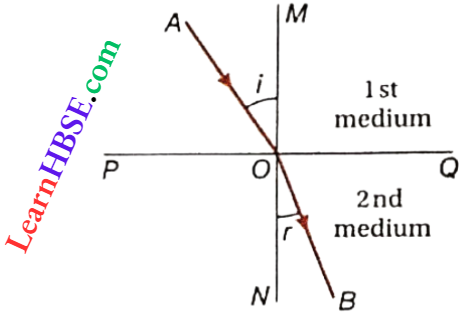
- On the other hand, if a negligible portion of the energy enters the second medium, the second medium is called an opaque medium. For light waves, wood, iron, brick walls, etc., are opaque media. Between them, ground glass, oily paper, etc., are semitransparent media.
PQ: Surface of separation of two media or the refracting surface
AO: Incidentally
O: Point of incidence
OB: Refracted ray i.e. the ray entering the 2nd medium.
MN: normal at the point of incidence on the refracting surface
∠AOM = i = angle of incidence
∠BON = r = angle of refraction
Reflection Of Waves At A Boundary Class 11
Laws Of Refraction Of light: Refraction of waves obeys the following two laws:
- The incident ray, the refracted ray, and the normal to the refracting surface at the point of incidence lie on the same plane.
- The ratio of the sine of the angle of incidence to the sine of the angle of refraction is a constant. The magnitude of the constant depends on the nature of the two media and the color of the incident wave.
Mathematically, \(\frac{\sin i}{\sin r}={constant}\left({ }_1 \mu_2\right)\)
where i and r are the angle of incidence and the angle of refraction, respectively, and μ is called the refractive index of the second medium with respect to the first medium. The second law of refraction is known as Snell’s Law.
The refractive index (1μ2) is also equal to the ratio of the wave velocities in the two media, i.e., \({ }_1 \mu_2=\frac{v_1}{v_2}; v_1\) and v2 are respectively the velocities of die waves in the first and the second medium. The medium with a smaller wave velocity is called a denser medium and the medium with greater wave velocity is called a rarer medium.
Rule governing the deviation of a ray: Generally, the direction of wave motion changes at the time of crossing the refracting surface, i.e., the ray changes its direction. The rule of deviation is as follows:
- When a ray enters a denser medium from a rarer one, the refracted ray bends towards the normal. In this case, the angle of refraction is less than the angle of incidence, i.e., r< i. Clearly, the second medium is denser than the first medium.
- When a ray enters a rarer medium from a denser one, the refracted ray bends away from the normal. In this case, the angle of refraction is greater than the angle of incidence, i.e., r> i.
Relation between incident and refracted waves
- Due to refraction, the frequency and the time period of waves do not change.
- The wavelength and the wave velocity suffer changes during refraction.
- The phase of the wave does not change during refraction, i.e., the phase difference between the incident wave and the refracted wave is zero.
In this chapter, only the phenomenon of refraction of sound will be discussed.
Reflection Of Mechanical Waves Class 11
Refraction Of Sound Waves : John Tyndall was the first to demonstrate refraction of sound through a balloon filled with carbon dioxide (CO2). The balloon, surrounded by air, behaves like a convex lens of glass surrounded by air for refraction of light.
- This is because carbon dioxide is heavier than air. If a clock is placed on one side of the balloon, the sound rays produced by the clock meet at a particular point on the other side after refraction through the balloon.
- If we place our ears at that point, the sound of the clock is heard distinctly. But sound will not be heard if we place our ears elsewhere.
- It is an important point to note that, the velocity of sound in air is nearly 330 m · s-1, whereas that in water is about 1500 m · s-1. As a consequence, unlike in the case of light waves, air is a medium denser than water for sound waves. So, when sound enters water from the air, the rays deviate away from the normal.
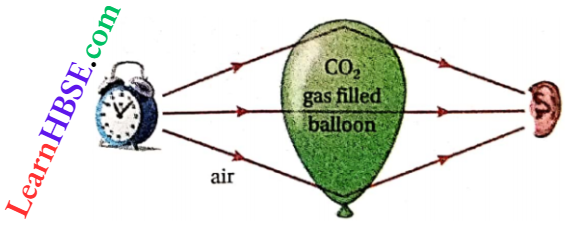
Steel is a still rarer medium, as the velocity of sound in it is about 5000 m · s-1. A convex-shaped steel lens or water lens placed in air would, thus, show the properties of a concave lens, i.e., would behave as a diverging lens.
Refraction Of Sound In The Atmosphere
Effect Of Temperature: The whole atmosphere over the surface of the earth may be supposed to be divided into layers, one above the other. At daytime, the layer of air adjacent to the surface of the earth has the highest temperature and as we move upwards the temperature falls gradually.
- So, the density of air increases with the increase of height from the surface of the earth. Thus, the upper layers of air are denser than the layers near the surface of the earth. Hence, the sound emitted from a source near the surface of the earth gets refracted.
- While propagating upwards due to refraction, it bends towards the normal at every layer and eventually travels upwards almost vertically. For this reason, only a negligible portion of the sound emitted from the source reaches a distant listener standing on the surface of the earth, i.e., at day time sound cannot travel a large distance in the forward direction.
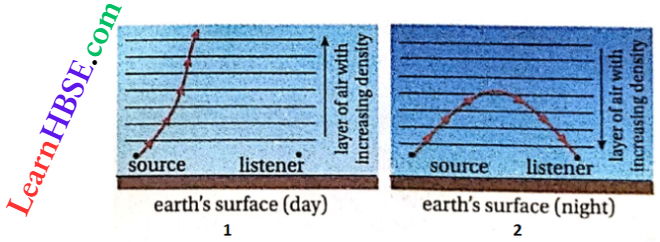
Reflection And Transmission Of Waves Class 11
Just the opposite happens m night, The density of the lowermost layer of air is maximum because its temperature is minimum. So, sound omitted from a source on the surface of the earth gets refracted while propagating upwards. In this case, sound moves from a denser to a rarer medium.
- So it bends away from the normal at every layer, At one stage, total internal reflection occurs and it begins to move downwards. Ultimately, it reaches a listener.
- So, the sound emitted from a distant source can be heard distinctly at night.
- Sound of a distant train, low voices of persons sitting in a boat floating in the middle of a river, etc., are very clear to our ears at night.
Numerical Problems On Reflection Of Waves Class 11
Effect Of Wind: Generally, the velocity of wind near the surface of the earth is less than that in the upper layers. If the wind blows from the source to the listener, the wavefronts at the lower levels have comparatively smaller velocities.
Hence, the wavefronts bend towards the earth and help the listener to hear the sound. So, under this condition, the sound coming from a distant source is heard distinctly.
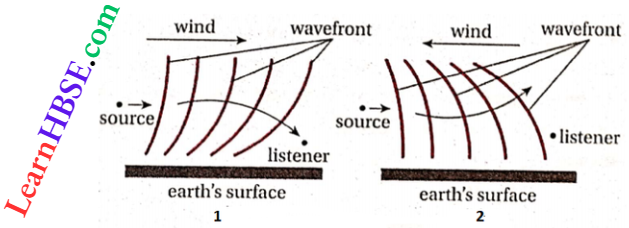
- On the other hand, if the wind blows in the opposite direction, i.e., from the listener to the source, an opposite incident happens. In this case, the wavefronts at the upper levels have comparatively smaller velocities.
- Hence, the wavefronts bend in the upward direction. So a very negligible portion of the sound can reach a distant listener standing on the surface of the earth. Therefore, under this condition, the sound coming from a distant source is not heard distinctly.
